Another gorgeous day for the Skagit Valley, and a sunlit breakfast waiting for us as we arrived for Day 2 :^)


…and, if you wished, you could have pie for breakfast! 
***
After breakfast, Andrew Whitley, co-founder of The Real Bread Campaign in the UK, led the day with his keynote address “Bread Matters”.
MC-Farine has a really good summary of Andrew’s talk here:
http://www.farine-mc.com/2012/09/andrew-whitley-bread-matters.html
Andrew described his realization that for some, tasting bread can take them back to a place where bread mattered.
It was very interesting to hear Andrew describe what motivated him to become a baker, write his book, and to co-found the Real Bread Campaign, in efforts to improve the state of bread in his home country. I’m sure Andrew’s efforts have brought much joy to people, firstly by baking good bread for them, and then by teaching how people to make it for themselves :^)
***
During the day, I popped in an out of the Professional Baking Class taught by Jesse Dodson (first picture below), Michael Eggebrecht and Martin Philip (second picture below).
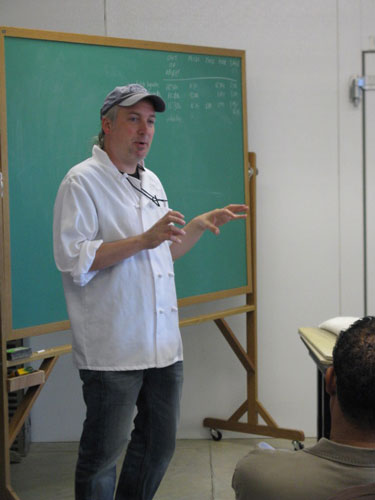
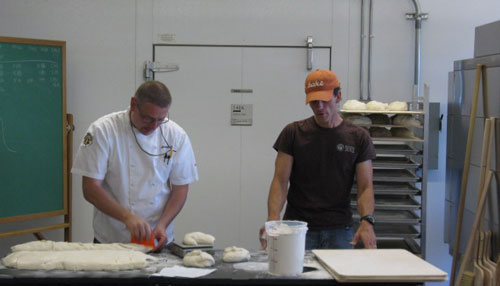
A wealth of knowledge with these three, and I tried to jot down interesting and helpful things they mentioned:
Whole Grains:
- whole-milled flour lasts longer (is more shelf-stable?) than flour that has been re-combined
- whole grains like to ferment a little warmer that white dough
- proofing for whole grains has to outpace the loss of gas; mix whole grains to 80F dough temperature, so the warmer temperature will promote faster gas production, resulting in shorter final proof/fast to the oven
- with whole grains, colder temperatures will amplify acetic flavors, warmer temperatures will amplify lactic flavors
Dough Temperature:

- a good dough temperature for a French bread (baguette dough) is low 70’s (F); mixing too warm will
result in a tighter crumb (wish I’d thought to ask why!)
- dough temperature and effect on duration of bulk fermentation (assumed to be happening at 70F room temperature): as a guide, you can expect a change of 7 minutes per degree per hour of fermentation; for example, ciabatta that might bulk ferment at 75F for 180 minutes (3 hours), if mixed to 78F instead of 75F, would have a 63-minute reduction in bulk fermentation time (7 minutes x 3 degree temperature difference x 3 hours original bulk fermentation = 63 minutes) – so your dough would bulk ferment 117 minutes instead of 180 minutes
- if trying to use environmental compensations (fridge, or a warming device) for dough temperature that didn’t hit the target, your dough will ferment unevenly around the perimeter)
Masters of shaping and scoring:
It was a pleasure to see these talented bakers working with the dough, shaping and scoring!
This is pre-shaped baguette dough:

Jesse demonstrating blade angle, batard scoring: 
Cutting épi de blé:


Steam:

- too little steam affects crust color and how cuts expand, but too much steam will also affect how cuts expand
- smaller loaves jump in the oven more quickly that larger ones, and so require less steam than larger loaves
Rye:
- the coarseness of the rye grind affects hydration but also the accessibility of the endosperm – what I understood Jesse to say was if the endosperm’s accessibility was reduced as a result of how the rye was milled, less starch could be converted to sugar and that would affect fermentation
- Jesse mentioned when baking dark rye, they tried steaming a second time, 8 minutes into the bake, and got another ½” of height in the baked loaves
- Andrew Ross noted, you can adjust the acidity in your dough if you know the amylase present (represented by falling number) in your flour, for a particular harvest
Baked!:

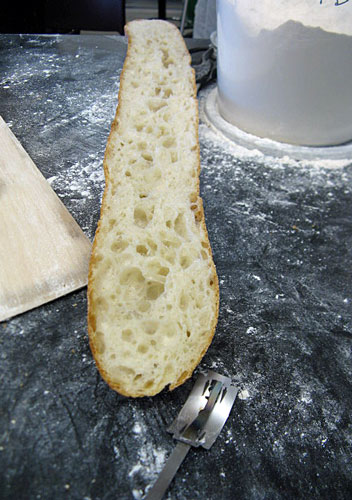
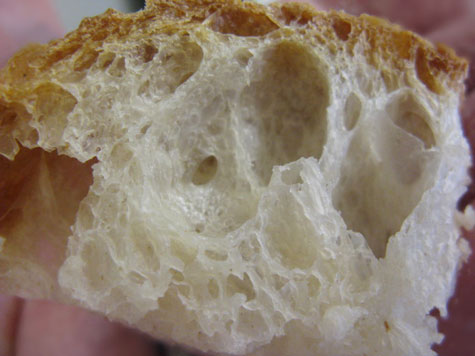

***
I would have loved to have caught Naomi Duguid and Dawn Woodward’s class “A World of Flatbreads” but did manage to get these pictures (flatbreads baking, tasty samples, and a happy dough, bubbling and fermenting away in the sunshine):
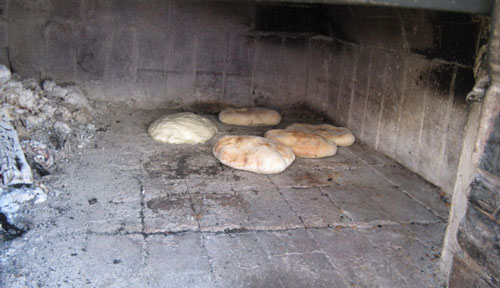


***
There was also an enormously fun demo by Mike Dash of Rolling Fire Pizza, with gorgeous and silky Caputo 00 dough for shaping and baking…

Guess which slice had my name on it? :^) 
***
There was an afternoon tour of the Bread Lab and demonstration of the various pieces of equipment used for testing flour properties – what wonderful tools to have to help determine the baking properties of the beautiful grain being grown at this WSU extension.
***
Later that afternoon, Naomi Duguid and Dawn Woodward, along with Gary Moulton, presented “Sensory Analysis of Cider, and How the Descriptives Relate to Bread”.

It was very interesting to consider the aroma and flavor descriptions that typically apply to wine, beer and cider and consider how those descriptions translate to the aroma and flavor of bread:

***
Then, more Skagit Valley Tastings! More delicious cider (apple, and a gorgeous blackcurrant from Finn River), accompanied by some beautiful barley bread, made by Andrew Ross (who taught a barley class last year at KCW), and Hannah Warren:





***
Also so enjoyable, the beautiful, sweet bouquet of sweet peas,
intensified by the warmth of the late summer sun... 
***
Then, a delicious BBQ dinner provided by Bonanza B-B-Q, as the sun started to set on this second, wonderful day :^) …
Previous: Kneading Conference West 2012 – Day 1
Next: Kneading Conference West 2012 – Day 3